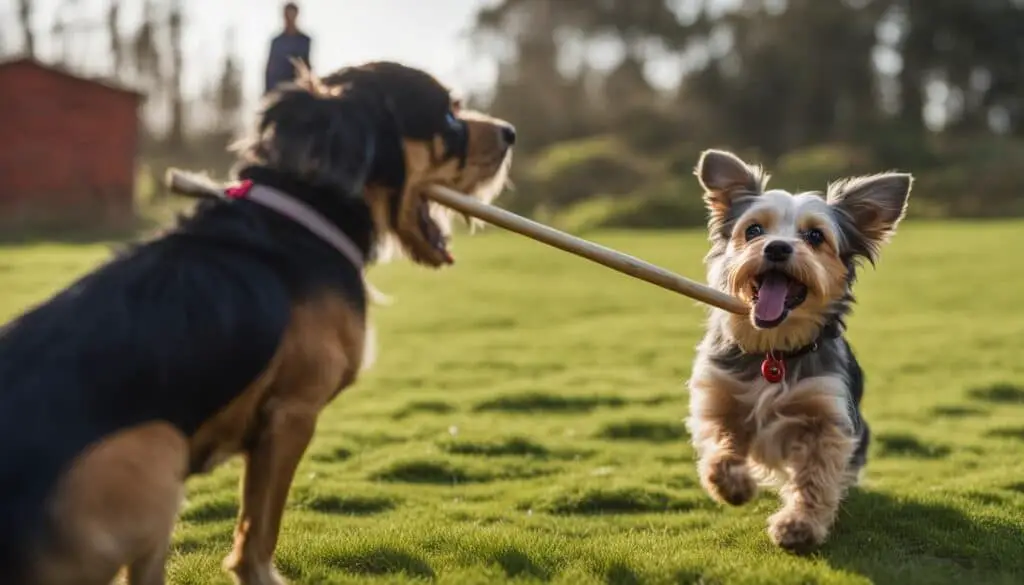Small-dog syndrome, also known as the “Napoleon complex” or “small-dog syndrome,” refers to the idea that small dogs exhibit aggressive or dominant behavior disproportionate to their size. Research suggests that small-dog syndrome is a real phenomenon characterized by behaviors like barking, growling, jumping, and nipping. These behaviors are often a result of the small dog getting away with bad behavior due to their size, as pet parents are less likely to correct or discipline them. Fear also plays a role in small-dog syndrome, with studies showing that small dogs have higher odds of displaying aggression due to fear. Socialization training, including interactions with larger dogs, can help manage and prevent small-dog syndrome.
Key Takeaways:
- Small-dog syndrome is a real phenomenon characterized by aggressive or dominant behavior in small dogs.
- Small dogs may exhibit behaviors like barking, growling, jumping, and nipping due to lack of correction or discipline.
- Fear plays a role in small-dog syndrome, leading to aggression.
- Socialization training, especially with larger dogs, can help manage and prevent small-dog syndrome.
- Understanding the factors contributing to small-dog syndrome can aid in addressing and managing small dog behavior problems.
Training Tips for Small Dogs
Training small dogs requires specific techniques tailored to their unique needs. While the principles of consistency, patience, and positive reinforcement apply to all dogs, there are some tips that can make training small dogs more effective. By following these training tips, small dog owners can manage and modify their dogs’ behavior in a positive and successful way.
1. Prioritize Consent and Positive Reinforcement
When training small dogs, it is important to prioritize their consent and agency. Allow the dog to choose their interactions and reward them with positive reinforcement instead of physically moving them. This builds trust and encourages the dog to engage in desired behaviors.
2. Use Small-Sized Treats and Play as Rewards
Using small-sized treats is essential to prevent overfeeding while training small dogs. Additionally, incorporating play as a reward can make training sessions more enjoyable for them. By using toys and playtime, small dogs are motivated to participate actively in training exercises.
3. Get on Their Level and Gradually Transition
During training sessions, it is beneficial to get on the same level as small dogs by sitting on the ground. This helps build a connection and makes it easier for them to understand instructions. Over time, gradually transition to an upright posture to establish proper obedience.
4. Use Management Tools
Management tools like leashes and harnesses can be effective in preventing undesirable behaviors in small dogs. These tools give pet owners better control and allow them to redirect their dogs’ attention when needed.

Remember that training is a lifelong commitment. It is important to approach training sessions with a positive and fun mindset, as small dogs respond well to encouragement and positive reinforcement. By following these training tips, small dog owners can effectively manage and modify their dogs’ behaviors, ensuring a harmonious and well-behaved furry companion.
Understanding Small Dog Behavior
When it comes to small dogs, their behavior can sometimes be misunderstood or misjudged. Excessive barking and perceived aggression are common problems associated with small breeds. However, it’s important to understand the factors that influence these behaviors.
One contributing factor is the small size of these dogs. Their instinct to protect themselves and their territory can manifest in excessive barking. They may feel the need to be vocal as a way of asserting their presence and warding off potential threats.
In addition, small dogs may be more prone to fear and anxiety. Their petite stature makes them more vulnerable, and this can lead to reactive or aggressive behavior when they feel threatened or scared. It’s crucial to provide them with a safe and secure environment to minimize these triggers.
Behavior problems in small dogs can also stem from inadequate training and socialization. With proper obedience training and exposure to different people, animals, and environments, small dogs can develop the necessary skills to navigate the world around them.
Addressing signs of aggression early on is crucial. Seeking the help of a professional dog trainer or behaviorist can provide valuable guidance and support. By implementing effective training techniques, socializing them with other dogs, and setting clear boundaries, behavior problems in small dogs can be managed and prevented.
FAQ
Is small dog syndrome a real phenomenon?
Yes, small dog syndrome, also known as the “Napoleon complex” or “small-dog syndrome,” is a real phenomenon characterized by aggressive or dominant behavior disproportionate to their size.
What causes small-dog syndrome?
Small-dog syndrome behaviors are often a result of the small dog getting away with bad behavior due to their size, as pet parents are less likely to correct or discipline them. Fear also plays a role, with studies showing that small dogs have higher odds of displaying aggression due to fear.
How can small-dog syndrome be managed and prevented?
Socialization training, including interactions with larger dogs, can help manage and prevent small-dog syndrome. Consistency, patience, and positive reinforcement are key in training small dogs. It is important to provide proper training, socialization, and boundary setting to manage and prevent aggression and behavior problems in small dogs.
What are some training tips for small dogs?
Prioritize consent and agency by allowing the dog to choose their interactions and using positive reinforcement. Use small-sized treats to prevent overfeeding and consider using toys and play as rewards. Get on their level and gradually transition to an upright posture during training sessions. Use management tools like leashes and harnesses to prevent undesirable behaviors. Training should be approached with a positive and fun mindset.
Why do small dogs bark excessively?
Small dogs may bark more as a way to protect themselves and their territory due to their small size. They may also exhibit fear and anxiety more easily, which can lead to reactive or aggressive behavior. Proper training, socialization, and addressing signs of aggression early can help manage and prevent excessive barking in small dogs.
What should I do if my small dog exhibits aggression or behavior problems?
If your small dog exhibits aggression or behavior problems, it is important to address them early and seek professional help if needed. Proper training, socialization, and boundary setting can help manage and prevent aggression and behavior problems in small dogs.
Source Links
- https://www.diamondpet.com/blog/culture/myths/is-small-dog-syndrome-real/
- https://www.baywoof.org/featured-article/are-tiny-dogs-harder-to-train-debunking-the-myth-of-small-dog-syndrome
- https://www.dabl.com/cesar-millan/cesar-911/articles/fact-or-myth-are-little-dogs-more-aggressive-and-yappy-big-dogs





No Comments